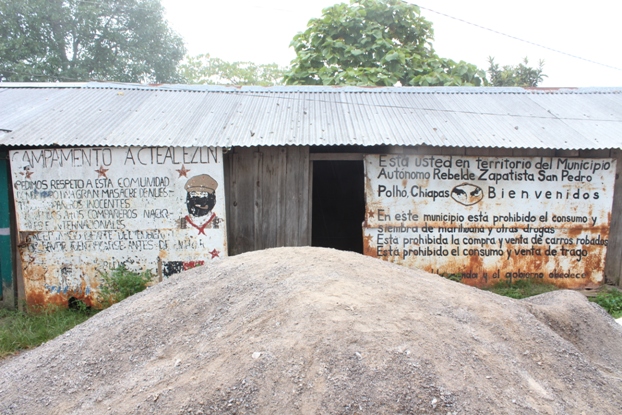By Geoffrey Ramsay*
 Mexico’s Zapatista Army of National Liberation (EZLN) is distinct from most other rebel organizations in Latin America, having remained within a democratic framework without getting involved in organized crime to secure funding.
Mexico’s Zapatista Army of National Liberation (EZLN) is distinct from most other rebel organizations in Latin America, having remained within a democratic framework without getting involved in organized crime to secure funding.
Because of its status as a major theater for proxy conflicts during the Cold War?, Latin America has a long history of leftist insurgencies. Over the past two decades, however, these left wing groups largely abandoned armed struggle as a means of gaining power, turning instead to peaceful electoral politics. In some countries they have been immensely successful. Indeed, the current ruling parties of Nicaragua, El Salvador, Brazil and Uruguay can all trace their roots — at least in part — back to guerrilla insurgencies of the 1970s and 80s.
Nevertheless, a handful of guerrilla movements persist in the region. The most well-known examples are in Colombia, which is home to the Revolutionary Armed Forces of Colombia and (FARC) and the National Army of Liberation (ELN). In Peru, two factions of the Shining Path still carry out deadly attacks on security forces, though the group is not the threat that it was at its peak in the early 1990s.
These three are generally cited as the most relevant insurgent groups in Latin America, and they have worked hard to maintain this status. All three have adopted illicit means of obtaining funding, including drug trafficking, bank robbery, kidnapping and extortion.
In this context, the high profile of Mexico’s largely indigenous Zapatista Army of National Liberation is incongruous. Although much of the organization’s social and political work is supported by international and domestic NGOs, the full nature of its funding is unclear. What is clear is that despite rising up in arms against in the southern state of Chiapas in 1994 and having since declared sizable parts of southern Mexico autonomous from the government, the EZLN has largely managed to refrain from criminal activity to support itself.
When criminal allegations have been leveled against them, such as when the group was suspected of carrying out the kidnapping of Mexican politician Diego Fernandez de Cevallos last year, the Zapatistas have vehemently denied them, and a congressional commission even acknowledged that the kidnapping didn’t fit the Zapatistas’ profile.
Their eschewal of crime is due largely to the fact that the EZLN is not a traditional guerrilla army. After their initial uprising in 1994, and the resulting San Andres peace accords in 1996, the group has largely refrained from illegal activity. Instead, they have become more of a grassroots social movement, establishing EZLN-affiliated autonomous communities in Chiapas and attempting to link far left community organizations throughout the country under the banner of a nationwide movement called the “Other Campaign.”
Indeed, the Zapatista’s most public spokesperson, alias “Subcomandante Marcos?,” has actively denounced armed groups which have attempted to ally themselves with the EZLN. Through well-publicized letters and communiques, he has castigated groups like the FARC and Spain’s ETA for killing civilians. Marcos has voiced aversion to armed struggle inside Mexico’s borders as well, distancing the EZLN from the small, Guerrero-based People’s Revolutionary Army (EPR), which is known for carrying out attacks on security forces and bombings of infrastructure targets in southern Mexico.
The fact that the EZLN refrains from armed and criminal activity likely has as much to do with self-preservation as it does with the group’s ideology. Since the 1994 uprising, the Mexican government has drastically increased its military presence in Chiapas. According to a 2004 study by the Center for Political Analysis and Social and Economic Research (CAPISE), there are at least 91 military bases in the state, many of which are located near Zapatista communities.
In more recent years, the military presence has increased even more in response to President Felipe Calderon?’s crackdown on drug trafficking organizations. The Sinaloa Cartel and Zetas are deepening their activities in neighboring Guatemala, a trend which Mexico is fighting by increasing the number of military checkpoints along the southern border (with mixed success).
Considering the high level of militarization of armed forces in the Zapatistas’ main area of influence, their cessation of military activity is not surprising. If they were to attempt another uprising, it would doubtlessly end in a devastating defeat.
The disincentive for the EZLN to mix itself up in criminal activity is just as strong. The Calderon administration’s security strategy has given the government a powerful policy narrative to justify dismantling drug traffickers’ community control. If provoked, the state could easily turn it against the Zapatistas.
By turning away from armed struggle, the group has also been afforded a certain amount of political legitimacy. Unlike their guerrilla cousins in Colombia and Peru, the Zapatistas have widespread support both from the Mexican left and on the global stage, where they are known as a spearhead of the anti-globalization movement. It should also be noted that the Zapatistas eschew conventional politics with the same ferocity. Ever since their inception they have rejected the notion of joining the Mexican political system, which they view as hopelessly corrupt.
* Source http://www.insightcrime.org/

